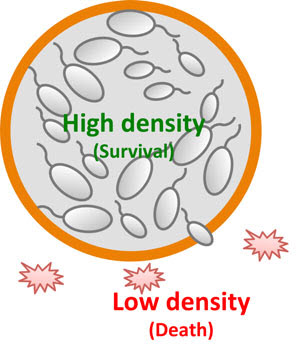Engineered swarmbots rely on peers for survival
February 29, 2016

Design and modeling of safeguard control in microbial swarmbots exhibit collective survival. Bacteria confined in the microbial swarmbot can maintain a high local density and survive. Cells escaping the swarmbot will have a reduced density due to a larger extra-capsule environment. If their density drops below their survival threshold, they will die, leading to safeguard control. (credit: Shuqiang Huang et al./Molecular Systems Biology)
Duke University researchers have engineered microbes as “swarmbots” designed to only survive in a crowd.
The system could be used as a safeguard to stop genetically modified organisms (created with tools such as CRISPR) from escaping into the surrounding environment.
Collective survival
“Other labs have addressed this issue by making cells rely on unnatural amino acids for survival or by introducing a ‘kill switch’ that is activated by some chemical,” said Lingchong You, the Paul Ruffin Scarborough Associate Professor of Engineering at Duke University. “Ours is the first example that uses collective survival as a way of intrinsically realizing this safeguard.*
“In general, this concept does not depend on the use of antibiotics,” said You. “We’re using non-pathogenic E. coli, but we hope to demonstrate that the same concept can be established with a probiotic strain of bacteria.” Another method would be to insert a contained population of bacteria that could help the body respond to intruders.
“This is the foundation,” said You. “Once we’ve established the platform, then we have the freedom to introduce whatever proteins we choose and allow these cells to engage in many different applications.”
The approach could also be used to reliably program colonies of bacteria to respond to changes in their surrounding environment, such as releasing specific molecules on cue.
Terrorism implications
On Feb. 9, James R. Clapper, U.S. Director of National Intelligence warned that “given the broad distribution, low cost, and accelerated pace of development of this dual-use technology, its deliberate or unintentional misuse might lead to far-reaching economic and national security implications.” It’s not clear if the swarmbot system could address that concern.
Research in genome editing conducted by countries with different regulatory or ethical standards than those of Western countries probably increases the risk of the creation of potentially harmful biological agents or products. Given the broad distribution, low cost, and accelerated pace of development of this dual-use technology, its deliberate or unintentional misuse might lead to far-reaching economic and national security implications.
The swarmbot system is described online, February 29, 2016, in an open-access paper in Molecular Systems Biology.
This work was supported by the National Science Foundation, the National Institutes of Health, the Army Research Office, and a David and Lucile Packard Fellowship.
* In the experiment, You and his colleagues engineered a non-pathogenic strain of E. coli to produce a chemical called AHL. They also modified the cells so that, in high enough concentrations, AHL causes them to produce an antidote to antibiotics. When the population of E. coli is dense enough, the antidote keeps them alive, even in the presence of antibiotics that would otherwise kill them.
The researchers then confined a sufficiently large number of the bacteria to a capsule and bathed it in antibiotics. As long as the E. coli remained inside their container where their density was high, they all survived. But if individual bacteria escaped, they were quickly killed off by the antibiotic.
Duke University | Swarmbots
Abstract of Coupling spatial segregation with synthetic circuits to control bacterial survival
Engineered bacteria have great potential for medical and environmental applications. Fulfilling this potential requires controllability over engineered behaviors and scalability of the engineered systems. Here, we present a platform technology, microbial swarmbot, which employs spatial arrangement to control the growth dynamics of engineered bacteria. As a proof of principle, we demonstrated a safeguard strategy to prevent unintended bacterial proliferation. In particular, we adopted several synthetic gene circuits to program collective survival in Escherichia coli: the engineered bacteria could only survive when present at sufficiently high population densities. When encapsulated by permeable membranes, these bacteria can sense the local environment and respond accordingly. The cells inside the microbial swarmbot capsules will survive due to their high densities. Those escaping from a capsule, however, will be killed due to a decrease in their densities. We demonstrate that this design concept is modular and readily generalizable. Our work lays the foundation for engineering integrated and programmable control of hybrid biological–material systems for diverse applications.
